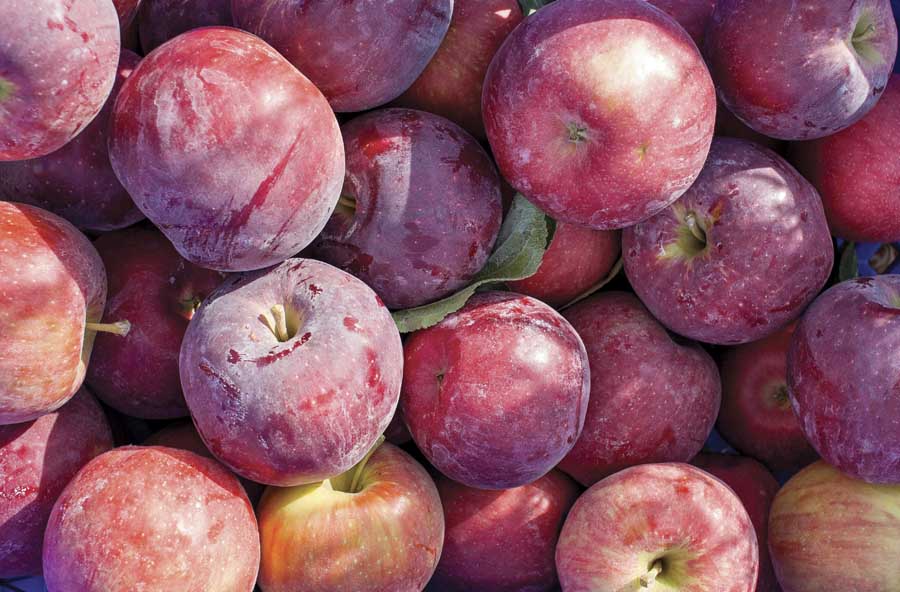
Washington State University researchers share what they’ve learned about WA 38 during a field day on September 24, 2015 near Quincy, Washington. (Shannon Dininny/Good Fruit Grower)
Washington State University’s new apple variety Cosmic Crisp (WA 38) continues to pass every test with flying colors.
Unlike Honeycrisp, which seems to suffer every ailment known to the apple industry, WA 38 has yet to show a serious weakness.
—It’s flavorful, extraordinarily crisp, and has flesh that doesn’t turn brown when cut.
—It bears annually and will consistently yield 80 bins per acre.
—It has a wide harvest window and can usually be picked in one go.
—It can be stored for at least six months without 1-MCP (1-methylcyclopropene) and year round with 1-MCP.
—It’s adaptable to a wide range of climates, tolerates heat, and does not develop delayed sunburn.
—It does not develop late bitter pit, scald, or internal browning in storage.
It’s so incredibly good, in fact, that Dr. Ines Hanrahan, projects manager with the Washington Tree Fruit Research Commission, had to remind growers at a recent WA 38 field day that she and her colleagues have no vested interest in the variety and have been trying hard to find something that’s wrong with it.
Strip picked

Craig Young (center) learns about the characteristics of WA 38 during a field day at Washington State University’s Sunrise Orchard between Wenatchee and Quincy on September 24, 2015. It is a vigorous variety well suited to a bi-axis system. (Geraldine Warner/Good Fruit Grower)
At the field day in Quincy, Washington, Hanrahan presented results of trials conducted last year at orchards in Prosser and Quincy, where the variety is being evaluated.
Each orchard was divided into three sections that were harvested at intervals of one week. Within each section, the fruit was strip picked. The goal was to find out if all the apples could be harvested in one pick and what would be the best timing.
The fruit held up well in storage, Hanrahan reported. Apples from each harvest date were stored for four months in regular storage or six or eight months in CA (controlled atmosphere) storage.
Some of the fruit in long-term storage were treated with MCP and some weren’t.
“The conclusion is, it’s possible to pick once and you have a two-week window to pick fruit for long-term storage,” she added.
Tom Auvil, research horticulturist with the Research Commission, said the variety has outstanding heat tolerance.
Whereas sun-exposed Gala, Red Delicious, or Golden Delicious apples can have a different color and woody texture as harvest approaches, fruit on WA 38 trees seem unaffected by heat.
Overhead cooling does seem to intensify the color a smidgen, Auvil said, but there’s been little difference in internal maturity of cooled versus uncooled fruit.
“We consider this variety one of the most resilient varieties we’ve worked with and one that has the fewest issues related to environmental problems,” he said.
The eating quality of WA 38 is consistent, whether it’s grown in the heat of Mattawa or the highlands of Brewster, as long as the fruit is picked at similar starch-conversion levels or maturity. “It’s unique in that aspect,” Auvil said.
WA 38 has more variation in appearance than in eating quality, he added, and is not a fully red apple, even though many of the fruit are dark red.
Some apples don’t turn red over the whole surface and a small percentage (perhaps 10 to 15 percent) will have a lighter, stripy color all over. Those paler apples won’t color any more after they reach 3 to 4 on the starch index scale of 1 to 6.
“I would absolutely consider this variety to be a bi-colored variety,” Auvil said. (Read more about how to grow WA 38)
As well as having the potential to be harvested efficiently, WA 38 should be a relatively trouble-free apple to store and pack.
If fruit is picked at the right maturity, it can be held until Valentine’s Day without CA, Hanrahan said.
It can be held in CA storage, in the standard atmosphere of 2 percent oxygen and 1 percent carbon dioxide, for at least six months without the need for 1-MCP and for at least 12 months with 1-MCP.
“You don’t have to do anything special in storage,” she said.
Another positive trait is that the apples are consistent in size. A fruit size analysis last year showed that 90 percent of the fruit fell within a four-size range.
However, there are some concerns.
The last couple of years, a green discoloration has been noticed on the shoulder of some of the fruit.
In most instances, it colors over during the two weeks before harvest, but at a couple of orchards it’s been a concern at harvest.
Hanrahan said scientists are doing mineral analysis to try to pinpoint the cause. This could be related to heat and water stress during exceptionally hot weather.
“We’re looking into it to make sure it’s not becoming a bigger problem,” she said.
The variety is prone to some splitting, particularly if there’s a light crop and the fruit is large, Auvil warned.
“If the weather breaks—let’s say we go from a 70°F high to 50°F with rain and cloud—you’re going to see splits show up way faster than you would ever see in Gala.”
However, splits can be easily managed by watching the weather and harvesting the fruit at the right maturity, Hanrahan added. •
– by Geraldine Warner






Leave A Comment